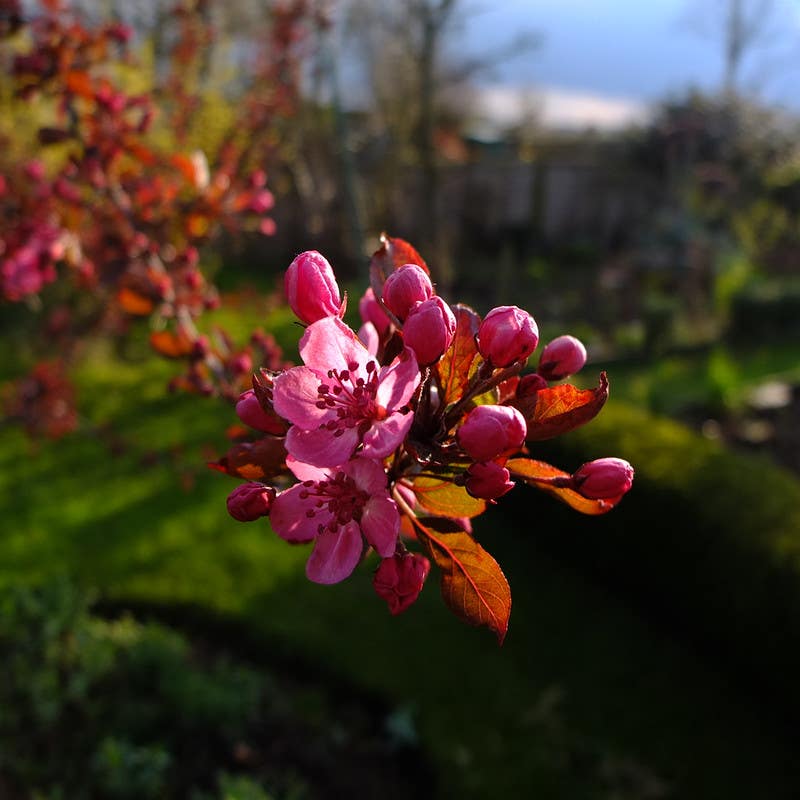Pruning Forsythia
How do I prune forsythia? I would like it to look natural, not like a hedge, but I want to trim it back because it’s getting large for its space.
Question: How do I prune forsythia? I would like it to look natural, not like a hedge, but I want to trim it back because it's getting large for its space.
Answer: While I can see the appeal of forsythia as a deciduous hedge, since it provides a thick screen of branches and green leaves in summer, a blooming forsythia hedge always makes me think of SpongeBob SquarePants. I get why you want to keep yours looking natural; the shrub has a rather elegant wild shape. The problem that usually arises is the shrub's size. Forsythia, when left alone, can easily reach a height of 10 feet, with a similar spread. It can spread even farther if its lowest branches touch the ground; they can root there and become new shrubs in their own right, until you have quite a thicket on your hands.
It's not easy to control a shrub's size by pruning—many sources will tell you in the long run it's simpler to choose a shrub whose natural size fits the space. There's a grain of truth to that, but I believe such advice glosses over the complicated matter that choosing a shrub can be. You must take into account exposure, soil type and pH and water needs, not to mention the aesthetic you desire for that spot in your garden. Perhaps you want a certain flower color, or something fragrant. Design experts encourage you to choose shrubs with more than one season of interest, and pick something that flowers when there's a lull in the overall scene. Adding all that together and hitting upon a choice that also naturally grows to just the right size and shape makes pruning sound easy as pie.
So I won't tell you to rip out your forsythia and replace it with a plant that stays small. Here are the steps to pruning a forsythia to control its size and keep it in its pleasant, natural vase shape:
Most sources will say prune it just after it blooms, so you won't sacrifice any flowers. You can prune it before it blooms, though, and that's the best time to assess and work with its bare-naked shape. A good pruning job will result in more flowers in subsequent years, because more light will reach interior stems. (If your forsythia is blooming only at the end of its branches, its likely shading itself and needs to be thinned.)
Identify the oldest stems, or canes, and prune them all the way down to the ground. The oldest ones will likely be tallest, if you haven't ever clipped them, and they will be the thickest, woodiest stems with a color duller than younger stems. They may be too thick at the base for bypass pruners; use a saw. Remove dead canes at the base too.
Next look at exterior canes and cut down any that are dipping to the ground and thus have the potential of rooting and sprouting new plants.
Cut out any canes that are growing in odd directions, such as through the center of the shrub and out the other side, or crossing other canes. The overall shape should be "up and out," like a vase. Select a few canes to remove from the center of the shrub, too, to promote airflow and light penetration.
Cut out canes that have been "headed off" in the past—in other words pruned back some distance to a bud, but not all the way to the ground. These canes will have stems shooting straight up from the point where they were cut and lower, contributing an overall cluttered look.
The general advice is to never remove more than one-third of the total shrub when pruning. Do that for three years and by the third, you'll have a rejuvenated shrub. However, with forsythia you may go so far as to cut all the canes to the ground in one go during late winter as a way to essentially start over. There will be no flowers at all that year, but fresh young stems will rise.
Keep in mind that it isn't going to look "perfect." Just do your best to remove the oldest canes, the dead ones and the most wayward ones, and always cut them right down to a stub, and you'll be ahead of the game.
Finally, if you cut forsythia branches for forcing in winter, always keep in mind that it's a form of pruning! New growth will sprout from the point where you cut. It may be best to cut canes as low as you can reach (snow may make it difficult to reach the ground) and shorten them up to fit your vases after you've brought them inside.
_____________________________________________________________________________
Looking for more tips on pruning? Check out Cass Turnbull's Guide to Pruning, a fabulous book that makes the subject approachable and doable.
Choose rugged yet beautiful shrubs and more for your garden with 50 Beautiful Deer-Resistant Plants.
A must-have for your garden library: Dirr's Encyclopedia of Trees and Shrubs.
Need some tools? Try these high-quality Premium Bypass Pruners







